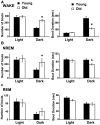Aging in mice reduces the ability to sustain sleep/wake states
- PMID: 24358130
- PMCID: PMC3864844
- DOI: 10.1371/journal.pone.0081880
Aging in mice reduces the ability to sustain sleep/wake states
Abstract
One of the most significant problems facing older individuals is difficulty staying asleep at night and awake during the day. Understanding the mechanisms by which the regulation of sleep/wake goes awry with age is a critical step in identifying novel therapeutic strategies to improve quality of life for the elderly. We measured wake, non-rapid eye movement (NREM) and rapid-eye movement (REM) sleep in young (2-4 months-old) and aged (22-24 months-old) C57BL6/NIA mice. We used both conventional measures (i.e., bout number and bout duration) and an innovative spike-and-slab statistical approach to characterize age-related fragmentation of sleep/wake. The short (spike) and long (slab) components of the spike-and-slab mixture model capture the distribution of bouts for each behavioral state in mice. Using this novel analytical approach, we found that aged animals are less able to sustain long episodes of wakefulness or NREM sleep. Additionally, spectral analysis of EEG recordings revealed that aging slows theta peak frequency, a correlate of arousal. These combined analyses provide a window into the mechanisms underlying the destabilization of long periods of sleep and wake and reduced vigilance that develop with aging.
Conflict of interest statement
Figures





References
-
- Bliwise DL (1993) Sleep in normal aging and dementia. Sleep 16: 40–81. - PubMed
-
- Dijk DJ, Beersma DG, van den Hoofdakker RH (1989) All night spectral analysis of EEG sleep in young adult and middle-aged male subjects. Neurobiol Aging 10: 677–682. - PubMed
-
- Dijk DJ, Duffy JF, Czeisler CA (2000) Contribution of circadian physiology and sleep homeostasis to age-related changes in human sleep. Chronobiol Int 17: 285–311. - PubMed
-
- Ehlers CL, Kupfer DJ (1989) Effects of age on delta and REM sleep parameters. Electroencephalogr Clin Neurophysiol 72: 118–125. - PubMed
-
- Landolt HP, Dijk DJ, Achermann P, Borbely AA (1996) Effect of age on the sleep EEG: slow-wave activity and spindle frequency activity in young and middle-aged men. Brain Res 738: 205–212. - PubMed
Publication types
MeSH terms
Grants and funding
LinkOut - more resources
Full Text Sources
Other Literature Sources
Medical

